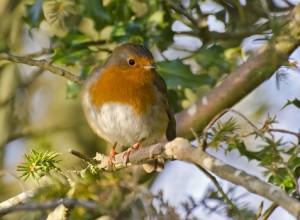
January can be a wet and uninviting month to explore the outdoors but fortunately it’s great for birdwatching as the cold weather brings birds into gardens, looking for food and shelter. Most birds will be sporting winter plumage, making each species more recognisable. It’s a perfect time for learning the different colours and behaviour of each species and how to improve habitats for your feathered friends.
Songbirds, also called passerines (perching birds – with three front toes and one back toe) are our most obvious and common garden visitors. These include, the friendly and familiar robins, the cheeky house sparrows and the noisy star-spangled starlings. With such wonderful personalities and beautiful songs, garden songbirds are must to attract, and with up to 30 different species can provide endless learning opportunities. I’ve listed ten things to investigate and do for birds.
Bird tables: Regular feeding throughout the year, especially in winter, will attract a wider variety of bird species to watch and study. There are many types of feeders that can be brought or made. Children love to design and make their own bird food recipes and a fun survey could record which recipes attracts which species. Then create your own menu board. Don’t forget to provide fresh water in a shallow bowl.
Make a viewing hide: For young children a bird hide or screen is essential to view birds up close. Hazel hurdles with rectangular gaps for viewing windows at different heights make the perfect screen. Sections can be moved and arranged near feeding stations and moved around the grounds to other habitats such as a pond.
Watching birds: For younger children binoculars are often too heavy and difficult to focus. A fixed telescope already focused on a bird table is easier to use. Use a box step for smaller children to stand on to look through the scope rather than adjusting the scopes height. Hint: get the children to cover the eye not looking down the scope and ask them what they can see to check they can focus.
Bird stalking: Using face paints to create camouflaged faces, small groups can creep or crawl along the ground to a set distance from a bird table. They can watch birds up close with just their eyes and learn the skills of being patient and quiet when watching wildlife. Lots of messy fun!
Identification: Whilst bird watching point out the amazing variety of shapes and sizes, colours and feathers. Look at beak shape and sizes – this will help with designing bird food menus. Record sightings directly at rspb.org.uk/birdwatch and help collect information about the health of bird populations – citizen science in action!
Behaviour: Each bird species have different behaviours and personalities. It’s fun for children to look and listen for different behaviours – which birds are the bossiest and who is more cautious. Watch birds sunbathing, taking a bath and preening, or trying to pull a worm out the ground. Maybe it could inspire a story or poem.
Birdsong: Learning birdsongs and calls takes practice but it’s wonderful to be able to recognise a few common garden birds by their song. Bird calls can be downloaded onto a tablet or phone and taken out with groups to listen too when bird watching. A great app for learning bird song on IoS is Chirp!
Make a next box: Birds are already checking out nest boxes and beginning to get territorial. Make sure to clean out existing nest boxes. Next month is National Nest Box week 14th-21st February – a good time to make and install additional boxes. A bird survey of the school grounds can help inform which species to attract. You could even put a webcam in a nesting box to record the chick’s growth – great life cycle study.
Winter weeds: Don’t tidy wildflower borders yet as these still provide food for birds and a home for over wintering insects. Leave teasels and sun flower heads, climbing plants such as ivy and honeysuckle berries and old bramble heads.
Bird friendly planting: Improve your gardens and grounds for wildlife. Apple or crab-apple, rowan, cherry, hawthorn and holly, all provide much welcome fruit and berries for birds in winter.
